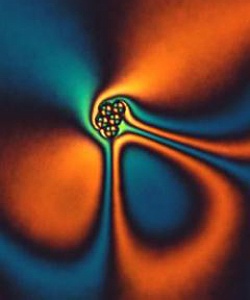Jan 10 2013
By showing that tiny particles injected into a liquid crystal medium behave as predicted by existing mathematical theorems, physicists have opened the door for the creation of a host of new materials with properties that do not exist in nature.
 Polarized light interacting with a particle injected into a liquid crystal medium. (Photo: Bohdan Senyuk and Ivan Smalyukh)
Polarized light interacting with a particle injected into a liquid crystal medium. (Photo: Bohdan Senyuk and Ivan Smalyukh)
The findings show that researchers can create a "recipe book" to build new materials of sorts using topology, a major mathematical field that describes the properties that do not change when an object is stretched, bent or otherwise “continuously deformed.”
Randall Kamien and Tom Lubensky, both professors in the University of Pennsylvania’s Department of Physics and Astronomy in the School of Arts and Sciences, contributed to a study lead by assistant professor Ivan Smalyukh of the University of Colorado, Boulder. Other collaborators include Sailing He of Zhejiang University in China and Robert Kusner of the University of Massachusetts, Amherst.
Their research was published in Nature.
The study is the first experiment to show that some of the most important topological theorems hold up in the real material world.
“The beauty of liquid crystals is that the abstract notions of topology can be directly visualized with a regular microscope,” Kamien said. “The striking, colorful figures reveal a more profound, underlying structure. It’s like music; after the first time you hear something you begin to realize that there is deeper structure.”
Smalyukh, postdoctoral researcher Bohdan Senyuk and doctoral student Qingkun Liu set up the experiment by creating colloids — solutions in which tiny particles are dispersed, but not dissolved, throughout a host medium.
For this study, the physicists created a colloid by injecting tiny particles into a nematic liquid crystal — a material used in flat-panel displays composed of rod-like molecules that align, in the absence of perturbing forces, along a single direction in space.
The researchers injected differently shaped particles that represent fundamental building-block shapes in topology. That means each of the particles is distinct from the others and one cannot be turned into the other without cutting or gluing. Objects that appear different can still be considered the same in topology if one can be turned into the other by stretching or bending, manipulations known as “continuous deformations.”
In the field of topology, for example, an object shaped like a donut and an object shaped like a coffee mug with a handle are treated the same, as one shape can be “continuously deformed” into the other. But a donut-shaped object cannot be turned into a sphere or a cylinder; no matter how much the donut is stretched or bent, it will always have a hole.
“By using particles with a varying number of handles,” Lubensky said, “this work is a beautiful extension of pioneering research carried out at Penn almost 15 years ago. That experiment explored how spherical particles, which have no handles, are forced by topology to behave within a nematic liquid crystal.”
As in the earlier experiment with spherical particles, the researchers were able to microscopically observe the handled particles behaving as predicted by topology once injected into the liquid crystal.
“Our study shows that interaction between particles and molecular alignment in liquid crystals follows the predictions of topological theorems, making it possible to use these theorems in designing new composite materials with unique properties that cannot be encountered in nature or synthesized by chemists,” Smalyukh said. “These findings lay the groundwork for new applications in experimental studies of low-dimensional topology, with important potential ramifications for many branches of science and technology.”